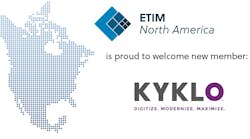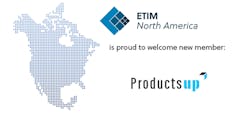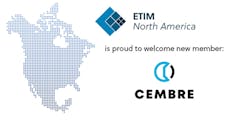Mike Rioux is sitting on top of one humongous pile of data: the Industry Data Warehouse's digital records for 1.3 million stock-keeping units (SKUs) of electrical products.
Managed by the four-year-old Industry Data Exchange Association (IDEA), Rosslyn, Va., and developed by some of the brightest minds in the electrical business, the IDW is by any measure the most accurate and updated electronic data bank in the entire electrical industry. The digital records are sliced and diced in a standardized industry format. IDEA's IDX2 electronic network that distributors and manufacturers can use to access the IDW's product information produces documented, real-world savings over other means of transmitting product data, either electronically or by other means.
The IDW product data stands ready and is waiting to be accessed by hordes of electrical distributors eager to drive down transaction costs and eliminate errors that occur with conventional transaction processes.
But you can understand why Mike Rioux, IDEA's president, sometimes feels like he and his staff are throwing a great party where few of the expected guests have arrived yet; IDEA's distributor subscriber base is relatively small with numbers in the dozens, rather than the hundreds that its built for.
Overall, at press time IDEA's Web site listed 158 electrical distributors as subscribers. Of those companies, 60 electrical distributors are paying for the IDW service. Out of those 60 firms, 40 companies are regularly accessing data daily or weekly. Rioux hopes to quadruple that number by taking some of the complexity out of integrating distributors' business systems with the IDEA.
Forty-seven electrical manufacturers — including many of the largest electrical companies — are transmitting, updating and maintaining their records electronically directly to the IDW, accounting for 65 percent of all of the IDW's records. Other manufacturers' data come from the i2/Trade Service database. IDEA estimates that the IDW's SKUs cover 85 percent of the electrical industry.
It's been four years since the National Electrical Manufacturers Association (NEMA), Rosslyn, Va., and the National Association of Electrical Distributors (NAED), St. Louis, formed IDEA as a joint venture non-profit electronic commerce service provider. The IDW and IDX2 are slowly but surely gaining traction, as Rioux and his staff are positioning the IDW as the electrical industry's portal for product and pricing information. Core to their quest is the same mantra that first sparked the concept for an IDW — the need for electrical manufacturers to control and maintain their own product data in a centralized data repository.
IDEA's 16-word mission statement is deceptively simple: “To provide for the efficient exchange of standard information and business transactions throughout the electrical industry.” To carry out this mission, over the past few years the IDW was developed as the central data warehouse for the electrical industry. IDEA's Industry Data Exchange 2, or IDX2, enables manufacturers, distributors and service providers to conduct partner-to-partner business document exchange on an Internet-based network using EDI, XML, flat file or Web form transaction sets. Developing the IDW and IDX2 has taken dozens of electrical distributors, manufacturers and reps hundreds of hours of work laboring over insane amounts of technical standards and other electronic minutia.
The appointment of Mike Rioux as president of IDEA in April 2000 brought a fresh perspective to a venture that saw more than its share of political in-fighting in its earliest years. Rioux is just as passionate about the IDW as IDEA's founding fathers. But his vision for IDW includes a much-needed outsider's perspective.
Rioux's background includes eight years as senior vice president of operations and safety for the Air Transport Association, where he helped develop the airline industry-owned business-to-business product and pricing program called SPEC 2000; 22 years in the Navy as a fighter pilot and instructor; and a two-year stint as chief operating officer for a high-tech engineering firm that provides technology solutions for commercial aviation. He brings a proactive, no-nonsense approach to the organization.
Rioux and IDEA have survived some big challenges in the last two years. It needed a $2 million cash infusion in March 2001 from 28 electrical distributors and electrical manufacturers to get on a firmer financial footing. And in November 2001, Rioux had to sever relations with MCI WorldCom, the developer of IDX. CCITriad, Livermore, Calif., which provides the service and software programming for the IDW, took the role of a communications provider and developed the IDX2 update earlier this year.
Certainly, the dot-bomb implosion didn't help IDEA or any other businesses marketing e-business products or services. But IDEA got some a big boost earlier this year from Graybar Electric Co., St. Louis, when Bob Reynolds, chief executive officer, gave a speech at the NAED annual meeting, urging manufacturers and distributors to support the IDW.
Reynolds said that as Graybar begins to use IDW in the ERP computer system that it's now installing, he will expect manufacturers to do a better job of providing the IDW with direct feeds of accurate, updated product data. The message was clear: If manufacturers want to do business with Graybar in the future, they need to get their information in the IDW via direct feed.
IDEA's Rioux said that after Reynolds' speech, IDEA got a lot of positive feedback and a surge of interest in IDX2. “That growth has been pretty tremendous,” he said. “We got more new customers in the three or four weeks after the Bob Reynolds speech than we had three months prior.”
Rioux says several other factors will contribute to the future growth of IDEA:
-
Adding “attributes” such as digital images or line drawings to data records.
-
Getting more manufacturers to provide “direct feeds” of data.
-
Convincing more distribution software vendors to provide systems that communicate seamlessly with IDEA.
-
Positioning the IDW as the electrical industry's primary data portal.
Attributed data
By the end of July, IDEA wants to have what's called a “schema,” or standard in place that all electrical manufacturers could use to load their product records in the IDW with attributed data. Attributed data has images, line drawings and additional information other than pricing and product features. A schema was first developed and beta-tested by lighting manufacturers, and is now being adapted to all other product categories by the electrical manufacturers providing data to IDEA.
As discussed in “The Perils of Pricing,” (EW — May 2002, p. 21), attributed data has another important feature: It can be used in the development of electronic catalogs and electronic storefronts because it can be searched by product feature. “The marketplace is going to drive the industry in that direction,” Rioux said in an interview for that article.
The E-Dataflex Catalog Content now offered by i2/Trade Service, Dallas, offers attributed data, and IDEA and i2 have had some discussions about using this data in the IDW database.
Direct data feeds
Getting more manufacturers to provide their data directly to IDEA in the format that fits the IDW standards is one of the keys to IDEA's future growth. Right now, about 65 percent (approximately 850,000 SKUs out of the 1.3 million SKUs in the database) comes to the IDW via direct feed. The other 35 percent comes from the i2/Trade Service database. Although IDEA has a good working relationship with i2 and is exploring other ventures with that company, getting manufacturers to transmit, control and maintain their own data was one of the very reasons that IDEA was founded, and it does not want to rely on i2 data.
“There are about 47 manufacturers directly providing data today,” said Rioux. “They are the large ones that have the bulk of the sales. Our goal is to get 100 new manufacturers directly sourced by September. If we can do that, I think we will see more distributors come to the IDW, because now they can get it directly from the manufacturers.”
Cooperation from business software providers
Rioux knows that to get more electrical distributors onboard with IDEA, he has to take some of the complexity out of the process of integrating a distributor's business software with the IDW. That's tricky, because not all of the major distribution software packages are compatible with the IDW. For instance, Array software provided by TradePower, Blue Bell, Pa., doesn't link up yet with the IDW.
“There are 300 TradePower Array customers sitting out there that are anxious to get access to the IDW, but they can't because of the software,” says Rioux. “I don't have any control over that. We have to rely on those guys to make the changes.”
Three software vendors that provide systems compatible with the IDW are Eclipse Inc., Shelton, Conn.; Prophet 21 Inc., Yardley, Pa.; and NxTrend, Colorado Springs, Colo.
Positioning the IDW as the industry's product data portal
IDEA's progress to date leads to a potential “killer application” that would knit together the IDW, IDX2 into a portal that the entire electrical industry could use to carry daily business transactions. This portal would take direct feeds from manufacturers to create electronic catalogs that distributors could use to order from their vendors. Rioux says IDEA is currently reviewing software that would allow for the delivery of information from disparate databases and aggregate it and deposit it into IDW and subsequently enable the creation of electronic catalogs. This software would also allow manufacturers to offer another important feature in their data: net pricing.
“If we take the current information that we have today — pricing — and marry it up with attributes and get an image, than in essence we can create an electronic catalog,” he said. “By having an electronic catalog posted on the IDW as a data portal, then we will enable the distributors to go into the Web site and select one or two options: download the information to their business systems, or use the IDW as an online query and purchasing engine.
“What that really means is that you could go into a vendor's online screen where it would list their products tabbed at the top. You could select the different products and would see that product or those products in a catalog, with all the information based on the field definition.”
If distributors see products they want to purchase, they would then initiate a purchase order transaction through several steps — click on an ‘Request for Quote (RFQ)’ or ‘Buy’ button, which would generate a net price request. Rioux says that price could be provided instantaneously through access that's stored in the IDW or the system could drill down into a manufacturer's business system, extract the information and then present it.
He says the availability of online net pricing is a real need in the market. “What we have heard more and more over the last six to seven months is, ‘All these pricing columns provided by Trade Service and you guys are nice, but what we want to know is what's the price that the manufacturer will charge the distributor. You don't need to tell me what I should charge a contractor.’ By having that “Buy” function on an Internet site, you could literally get that net price and use that to put your purchase in.
“For us, that's probably the next major tipping point that will differentiate us from others — we would have the info directly from the manufacturers and the mechanism to deliver it. The last piece is providing net price.”
Down the road, Rioux says a big challenge will be getting a handle on the actual return on investment that the IDW offers. It's relatively easy to measure the savings that IDX2 offers because users can directly compare the costs with their previous value-added network (VAN) or other method of processing purchasing orders.
“When you take that cost and compare it against what we charge, then it is pretty much a mathematical analysis of the problem,” says Rioux. “When you talk about data and the whole process of taking information from a central repository and proceeding with a purchase order and measuring that against another process that they have been familiar with, then that is a much more difficult problem to solve.”
To help, IDEA is working with NEMA's new Business Information Services, which offers consulting and project services, to develop an online calculator that companies can use to insert their own data, and then generate a cost-savings model or picture for them if they use the IDW or IDX2.
As if the challenge of getting more electrical distributors and manufacturers to sign on with IDEA isn't enough, Rioux believes IDEA's business model for the electrical industry will also work in other distribution-based industries, such as industrial supplies, pipe valves and fittings, and HVAC. He sees revenue growth for IDEA in these businesses, too. “The only question is how fast,” he says.
MEET MIKE RIOUX
Mike Rioux is one of the more interesting guys you will meet in the electrical industry. He was in the Navy for 22 years, serving as a Naval aviator with four fighter squadrons on four aircraft carriers. He was also a Top Gun instructor and commanding officer of an F-14 squadron.
Along with earning a master's degree in systems engineering at University of Southern California and a bachelor's degree in business management at the University of Maryland, he spent eight years as senior vice president of operations and safety for the Air Transport Association, where he helped develop the airline industry-owned B2B product and pricing program called SPEC 2000. After this post at the Air Transport Association, in 1998 became chief operating officer of JDA Technology Solutions, a high-tech engineering firm that provides technology solutions for commercial aviation.
IDEA TIMELINE
March 1998 - NEMA and NAED form joint venture corporation IDEA as a not-for-profit e-commerce company.
March 1998 - NEMRA and Electro Federation endorse IDEA
June 1998 - CCITriad contracted to develop and manage IDW
July 1998 - Trade Service Corp. signs agreement with IDEA
May 1999 - MCI WCOM contracted to develop and manage IDX
November 1999 - IDW and IDX become operational
January 2000 - IDEA becomes incorporated in Delaware as a for-profit company
April 2000 - IDEA board of directors appoints Michael Rioux as first full-time president
November 2000 - Richard Buzun, Siemens Energy & Automation, elected as new IDEA board chairman
November 2001 - IDEA and MCI WCOM agree to end IDX relationship early
December 2001 - CCITriad contracted to develop and manage IDX2
February 2002 - B&K Electric Supply is first IDX2 production customer
March 2002 - IDEA completes transition to IDX2; all IDX customers operational on IDX2
IDEA'S BOARD OF DIRECTORS
John Peterson, vice president of marketing, Cooper Industries
Todd Kumm, vice president of finance, Dakota Supply Group
Doug Baldwin, president, Electro-Federation of Canada
Stuart Scott, chief information officer, GE Industrial Systems
Deborah Weis, director of e-business, Graybar Electric Co.
Timothy Powers, president and chief executive officer Hubbell Inc.
Michael Rioux, president IDEA
Tom Naber, president/publisher, NAED
Malcolm O'Hagan, president, NEMA
Rick Bumpus, vice president of operations, North Coast Electric
Jay Platt, president and chief executive officer, Platt Electric Supply
Jeff Banaszynski, senior vice president, global sales, Rockwell Automation/Allen-Bradley
Bob Ciurczak, director of electronic commerce, Square D Co.
Stuart Irby, president, Stuart C. Irby Co.
Vic Jury, president, Summit Electric Supply Co.








